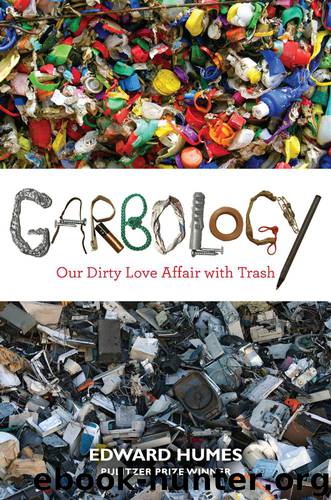Garbology: Our Dirty Love Affair With Trash by Edward Humes

Author:Edward Humes [Humes, Edward]
Language: eng
Format: epub
Tags: Travel, Social Science, Sociology, Technology & Engineering, Environmental, Waste Management
ISBN: 1583334343
Google: IjmxL_Ri77gC
Amazon: B0072NZZS0
Publisher: Avery
Published: 2012-04-19T04:00:00+00:00
TRASHY DELUSIONS
From a Garbage Project study for the U.S. Department of Agriculture, on the Lean Cuisine syndrome (how people overestimate and underestimate their consumption of certain foods based on whether they are fattening or not):
ONE DAY, after some sixteen years of trash sorting and household consumer surveys, Rathje and a colleague were discussing the Garbage Project’s latest findings. The other archaeologist heartily congratulated Rathje for all the fine work, but then made a pithy observation. “That’s great and all, but where’s the dirt, Bill? If there’s no dirt, it’s not archaeology.”
Rathje was brought up short by this. His colleague was right: Archaeologists dig. If they wanted to do real archaeology, garbologists would have to dig, too. Why hadn’t he thought of this before? It was time to stop bringing the garbage home, and start bringing their project to the garbage.
Thus began years of plumbing the depths of landfills—twenty-one of them, all over the country, more than 130 tons pulled up by the bucket augur before Rathje finally called it quits after more than thirty years as the world’s leading garbologist.
The single most startling finding from Rathje’s excavations was that garbage does not decompose inside landfills as most people, including sanitation experts, believed. A well-maintained, airtight, dry sanitary landfill was more like a mummifier of trash than a decomposer of trash, Rathje found. Fifty-year-old newspaper was intact and readable, headlines about President Truman’s electoral chances still bold and black on the front page. Steaks and hot dogs came up intact after decades. (But kaiser rolls? Not so much: Exhumed, they looked remarkably like ancient, mossy granite grinding disks used to make prehistoric cornmeal. Then Rathje spotted the poppy seeds and realized he had not fallen through some weird trash time warp that put Stone Age tools in the same landfill stratum as bottle caps and an exhausted tube of hemorrhoid cream.) Landfills, the Garbage Project diggers proved, were in many ways like giant time capsules, preserving for decades the seemingly perishable items we expected would turn to organic mush, while other items very, very slowly decomposed. There’s enough decomposition to generate a steady flow of methane, but at a slow enough rate that organic waste remains recognizable for a long time—grass clippings still green after fifteen years, onion peels and carrot tops hanging in there after twenty—which means that the methane flow can continue for a very long time, too.
According to Rathje, these findings, while unsettling to the orthodoxy, are a good thing. It means some of the potentially toxic juices people feared would leach out of landfills are basically just sitting there. This stability had long been recognized as the silver lining of plastic trash that we fail to recycle–it didn’t decompose, and so posed no environmental hazard as long as it was contained in a landfill. On the other hand, the materials that people had hoped would biodegrade—even the stuff officially designated as (or specifically designed to be) biodegradable—didn’t break down as expected in landfills, either.
There was a bad-news, good-news finding on hazardous waste in municipal landfills, too.
Download
This site does not store any files on its server. We only index and link to content provided by other sites. Please contact the content providers to delete copyright contents if any and email us, we'll remove relevant links or contents immediately.
| Acoustics | Bridges |
| Earthwork Design | Environmental |
| Fire Science | Highway & Traffic |
| Hydrology | Remote Sensing |
| Seismic Design | Structural |
| Structural Dynamics | Surveying & Photogrammetry |
| Transportation |
Whiskies Galore by Ian Buxton(40733)
Introduction to Aircraft Design (Cambridge Aerospace Series) by John P. Fielding(32377)
Small Unmanned Fixed-wing Aircraft Design by Andrew J. Keane Andras Sobester James P. Scanlan & András Sóbester & James P. Scanlan(32157)
Craft Beer for the Homebrewer by Michael Agnew(17475)
Turbulence by E. J. Noyes(7090)
The Complete Stick Figure Physics Tutorials by Allen Sarah(6661)
Kaplan MCAT General Chemistry Review by Kaplan(6089)
The Thirst by Nesbo Jo(5821)
Bad Blood by John Carreyrou(5801)
Learning SQL by Alan Beaulieu(5450)
Weapons of Math Destruction by Cathy O'Neil(5077)
Man-made Catastrophes and Risk Information Concealment by Dmitry Chernov & Didier Sornette(4784)
iGen by Jean M. Twenge(4716)
Digital Minimalism by Cal Newport;(4616)
Life 3.0: Being Human in the Age of Artificial Intelligence by Tegmark Max(4542)
Audition by Ryu Murakami(4127)
Electronic Devices & Circuits by Jacob Millman & Christos C. Halkias(4067)
1,001 ASVAB Practice Questions For Dummies by Powers Rod(4062)
Pale Blue Dot by Carl Sagan(4038)
